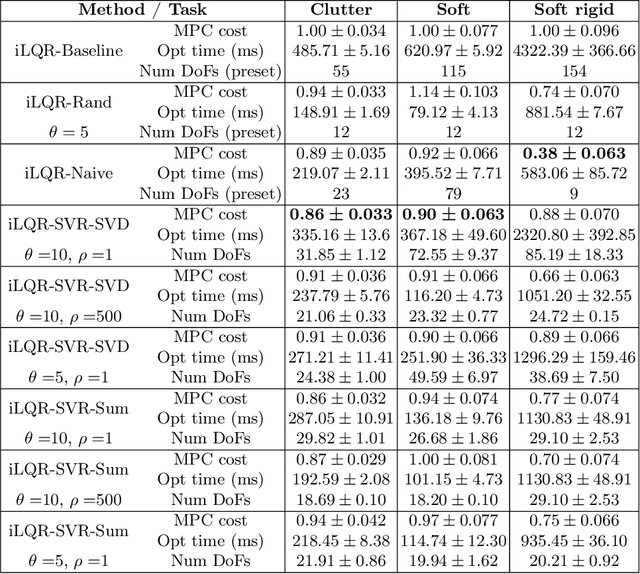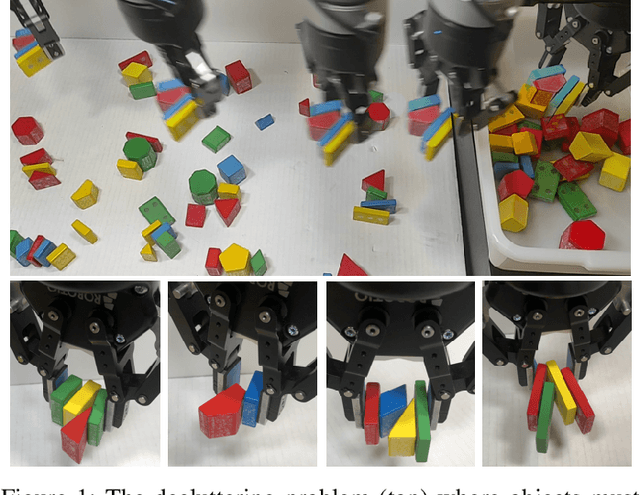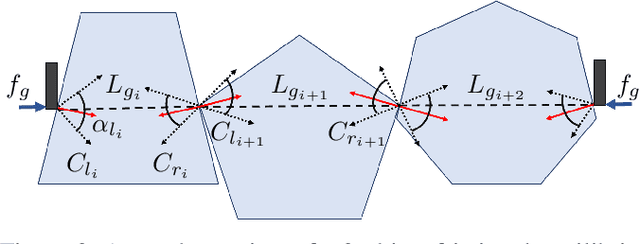Mehmet Dogar
University of Leeds
Online state vector reduction during model predictive control with gradient-based trajectory optimisation
Aug 21, 2024



Abstract:Non-prehensile manipulation in high-dimensional systems is challenging for a variety of reasons, one of the main reasons is the computationally long planning times that come with a large state space. Trajectory optimisation algorithms have proved their utility in a wide variety of tasks, but, like most methods struggle scaling to the high dimensional systems ubiquitous to non-prehensile manipulation in clutter as well as deformable object manipulation. We reason that, during manipulation, different degrees of freedom will become more or less important to the task over time as the system evolves. We leverage this idea to reduce the number of degrees of freedom considered in a trajectory optimisation problem, to reduce planning times. This idea is particularly relevant in the context of model predictive control (MPC) where the cost landscape of the optimisation problem is constantly evolving. We provide simulation results under asynchronous MPC and show our methods are capable of achieving better overall performance due to the decreased policy lag whilst still being able to optimise trajectories effectively.
The Teenager's Problem: Efficient Garment Decluttering With Grasp Optimization
Oct 25, 2023



Abstract:This paper addresses the ''Teenager's Problem'': efficiently removing scattered garments from a planar surface. As grasping and transporting individual garments is highly inefficient, we propose analytical policies to select grasp locations for multiple garments using an overhead camera. Two classes of methods are considered: depth-based, which use overhead depth data to find efficient grasps, and segment-based, which use segmentation on the RGB overhead image (without requiring any depth data); grasp efficiency is measured by Objects per Transport, which denotes the average number of objects removed per trip to the laundry basket. Experiments suggest that both depth- and segment-based methods easily reduce Objects per Transport (OpT) by $20\%$; furthermore, these approaches complement each other, with combined hybrid methods yielding improvements of $34\%$. Finally, a method employing consolidation (with segmentation) is considered, which manipulates the garments on the work surface to increase OpT; this yields an improvement of $67\%$ over the baseline, though at a cost of additional physical actions.
The Busboy Problem: Efficient Tableware Decluttering Using Consolidation and Multi-Object Grasps
Jul 08, 2023



Abstract:We present the "Busboy Problem": automating an efficient decluttering of cups, bowls, and silverware from a planar surface. As grasping and transporting individual items is highly inefficient, we propose policies to generate grasps for multiple items. We introduce the metric of Objects per Trip (OpT) carried by the robot to the collection bin to analyze the improvement seen as a result of our policies. In physical experiments with singulated items, we find that consolidation and multi-object grasps resulted in an 1.8x improvement in OpT, compared to methods without multi-object grasps. See https://sites.google.com/berkeley.edu/busboyproblem for code and supplemental materials.
Real-Time Physics-Based Object Pose Tracking during Non-Prehensile Manipulation
Nov 24, 2022Abstract:We propose a method to track the 6D pose of an object over time, while the object is under non-prehensile manipulation by a robot. At any given time during the manipulation of the object, we assume access to the robot joint controls and an image from a camera looking at the scene. We use the robot joint controls to perform a physics-based prediction of how the object might be moving. We then combine this prediction with the observation coming from the camera, to estimate the object pose as accurately as possible. We use a particle filtering approach to combine the control information with the visual information. We compare the proposed method with two baselines: (i) using only an image-based pose estimation system at each time-step, and (ii) a particle filter which does not perform the computationally expensive physics predictions, but assumes the object moves with constant velocity. Our results show that making physics-based predictions is worth the computational cost, resulting in more accurate tracking, and estimating object pose even when the object is not clearly visible to the camera.
Learning to Efficiently Plan Robust Frictional Multi-Object Grasps
Oct 13, 2022



Abstract:We consider a decluttering problem where multiple rigid convex polygonal objects rest in randomly placed positions and orientations on a planar surface and must be efficiently transported to a packing box using both single and multi-object grasps. Prior work considered frictionless multi-object grasping. In this paper, we introduce friction to increase picks per hour. We train a neural network using real examples to plan robust multi-object grasps. In physical experiments, we find an 11.7% increase in success rates, a 1.7x increase in picks per hour, and an 8.2x decrease in grasp planning time compared to prior work on multi-object grasping. Videos are available at https://youtu.be/pEZpHX5FZIs.
How accurate models of human behavior are needed for human-robot interaction? For automated driving?
Feb 12, 2022


Abstract:There are many examples of cases where access to improved models of human behavior and cognition has allowed creation of robots which can better interact with humans, and not least in road vehicle automation this is a rapidly growing area of research. Human-robot interaction (HRI) therefore provides an important applied setting for human behavior modeling - but given the vast complexity of human behavior, how complete and accurate do these models need to be? Here, we outline some possible ways of thinking about this problem, starting from the suggestion that modelers need to keep the right end goal in sight: A successful human-robot interaction, in terms of safety, performance, and human satisfaction. Efforts toward model completeness and accuracy should be focused on those aspects of human behavior to which interaction success is most sensitive. We emphasise that identifying which those aspects are is a difficult scientific objective in its own right, distinct for each given HRI context. We propose and exemplify an approach to formulating a priori hypotheses on this matter, in cases where robots are to be involved in interactions which currently take place between humans, such as in automated driving. Our perspective also highlights some possible risks of overreliance on machine-learned models of human behavior in HRI, and how to mitigate against those risks.
Parareal with a Learned Coarse Model for Robotic Manipulation
Dec 12, 2019



Abstract:A key component of many robotics model-based planning and control algorithms is physics predictions, that is, forecasting a sequence of states given an initial state and a sequence of controls. This process is slow and a major computational bottleneck for robotics planning algorithms. Parallel-in-time integration methods can help to leverage parallel computing to accelerate physics predictions and thus planning. The Parareal algorithm iterates between a coarse serial integrator and a fine parallel integrator. A key challenge is to devise a coarse level model that is computationally cheap but accurate enough for Parareal to converge quickly. Here, we investigate the use of a deep neural network physics model as a coarse model for Parareal in the context of robotic manipulation. In simulated experiments using the physics engine Mujoco as fine propagator we show that the learned coarse model leads to faster Parareal convergence than a coarse physics-based model. We further show that the learned coarse model allows to apply Parareal to scenarios with multiple objects, where the physics-based coarse model is not applicable. Finally, We conduct experiments on a real robot and show that Parareal predictions are close to real-world physics predictions for robotic pushing of multiple objects. Some real robot manipulation plans using Parareal can be found at https://www.youtube.com/watch?v=wCh2o1rf-gA .
Manipulation Planning under Changing External Forces
Jul 30, 2018



Abstract:In this work, we present a manipulation planning algorithm for a robot to keep an object stable under changing external forces. We particularly focus on the case where a human may be applying forceful operations, e.g. cutting or drilling, on an object that the robot is holding. The planner produces an efficient plan by intelligently deciding when the robot should change its grasp on the object as the human applies the forces. The planner also tries to choose subsequent grasps such that they will minimize the number of regrasps that will be required in the long-term. Furthermore, as it switches from one grasp to the other, the planner solves the problem of bimanual regrasp planning, where the object is not placed on a support surface, but instead it is held by a single gripper until the second gripper moves to a new position on the object. This requires the planner to also reason about the stability of the object under gravity.We provide an implementation on a bimanual robot and present experiments to show the performance of our planner.
 Add to Chrome
Add to Chrome Add to Firefox
Add to Firefox Add to Edge
Add to Edge